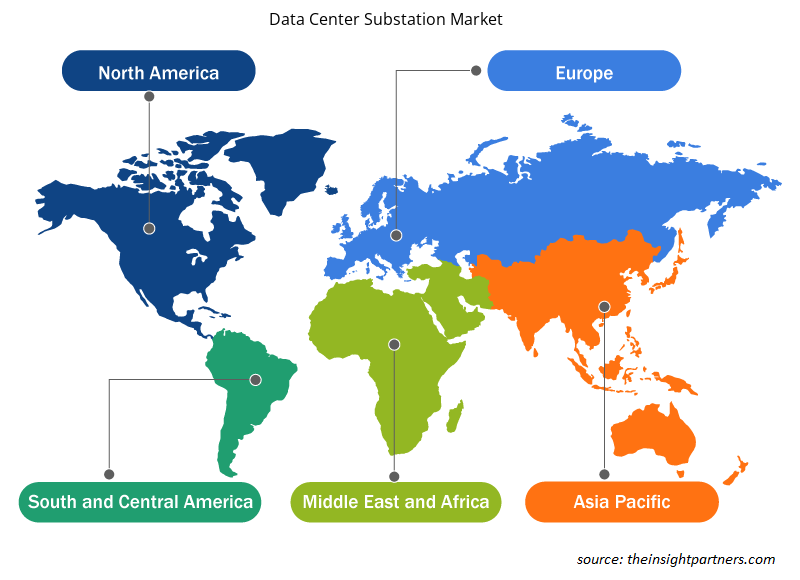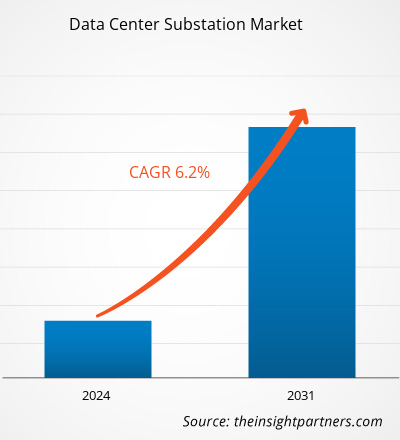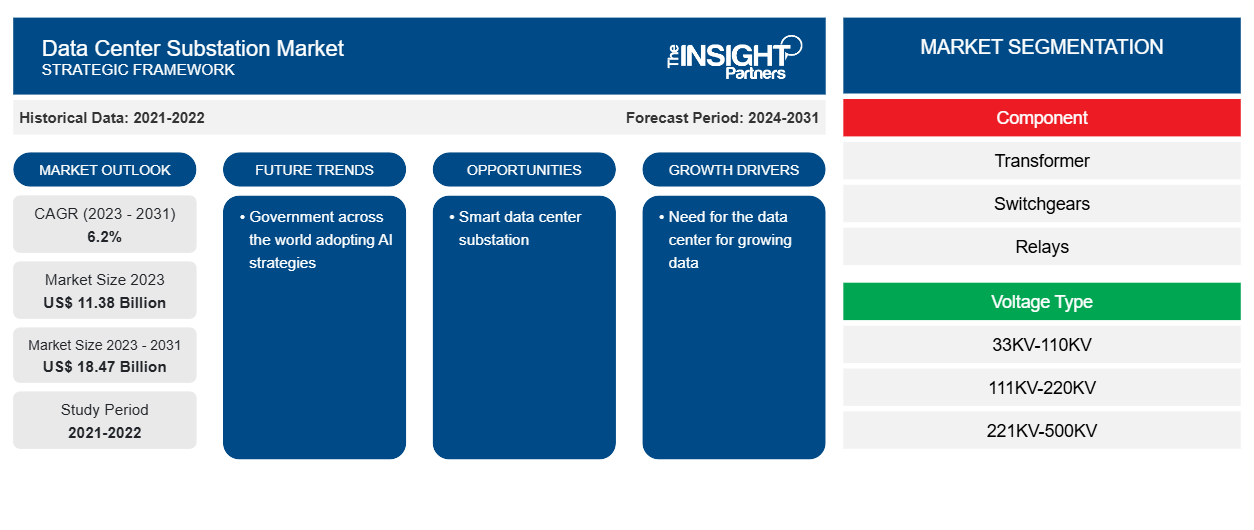Si prevede che la dimensione del mercato delle sottostazioni dei data center raggiungerà i 18,47 miliardi di dollari entro il 2031, rispetto agli 11,38 miliardi di dollari del 2023. Si prevede che il mercato registrerà un CAGR del 6,2% nel periodo 2023-2031. La crescita dei data center in tutto il mondo e la necessità di un'alimentazione efficiente, fluida e affidabile per i data center rimarranno probabilmente tendenze chiave nel mercato.
Analisi di mercato delle sottostazioni del data center
Il crescente numero di data center in tutto il mondo sta determinando la necessità di un'alimentazione efficiente, che alimenta ulteriormente il mercato delle sottostazioni dei data center. Le aziende che espandono le loro attività in tutto il mondo stanno lanciando il loro data center o optando per servizi di colocation, alimentando ulteriormente la necessità di data center. I dati in crescita stanno generando la necessità di storage dove possono essere elaborati e analizzati, alimentando ulteriormente la necessità di data center. Pertanto, la crescente necessità di data center sta alimentando il mercato delle sottostazioni dei data center per l'alimentazione efficiente durante la costruzione e il funzionamento del data center.
Panoramica del mercato delle sottostazioni del data center
Una sottostazione di un data center è una struttura che svolge un ruolo fondamentale nella rete elettrica che trasferisce l'energia dalla produzione al consumo. La sottostazione aiuta a proteggere l'apparecchiatura da guasti o cortocircuiti ed evita danni alle linee elettriche e alle apparecchiature. I provider di data center contattano il fornitore di servizi per costruire una sottostazione nel loro campus o per costruirne una e consegnarla al data center.
Personalizza questo report in base alle tue esigenze
Riceverai la personalizzazione gratuita di qualsiasi report, comprese parti di questo report, o analisi a livello nazionale, pacchetto dati Excel, oltre a usufruire di grandi offerte e sconti per start-up e università
-
Scopri le principali tendenze di mercato in questo rapporto.Questo campione GRATUITO includerà analisi di dati che spaziano dalle tendenze di mercato alle stime e alle previsioni.
Driver e opportunità del mercato delle sottostazioni dei data center
Necessità del data center per la crescita dei dati per favorire il mercato
I dati vengono generati a un ritmo più veloce. L'aumento della penetrazione di Internet ha alimentato la generazione di dati. Le aziende di tutto il mondo si affidano alla pianificazione strategica basata sui dati per una crescita aziendale efficiente. Inoltre, l'IoT genera un numero enorme di dati che devono essere elaborati, archiviati e analizzati in tempo reale. Si prevede che l'implementazione del 5G aumenterà significativamente il volume del traffico dati, poiché il 5G offre dati molto più elevati e una latenza inferiore rispetto al 4G e ad altre reti. Secondo i report di Cisco, il 5G supporterà oltre il 10% delle connessioni mobili del mondo entro il 2023, con una velocità media di 575 Mbps. È 13 volte più veloce della connessione mobile media odierna. A causa dell'aumento del traffico dati, le aziende e le imprese cercheranno una posizione in cui archiviare, elaborare e distribuire i propri dati in modo più efficiente e affidabile, contribuendo alla necessità di provider di data center. Pertanto, per gestire efficacemente la rete elettrica di un data center, la domanda di sottostazioni di data center è in crescita.
Sottostazione del data center intelligente
I governi di vari paesi stanno monitorando attentamente la costruzione di data center e garantendo la sostenibilità durante lo sviluppo e il lavoro sui data center. Il governo è concentrato sulla riduzione della sua impronta di carbonio e sulla gestione delle preoccupazioni derivanti dalle strutture ad alta intensità energetica. Pertanto, gli operatori di mercato sono concentrati sulla costruzione di soluzioni di sottostazioni di data center intelligenti per promuovere efficacemente il settore dei data center. Ad esempio, ABB fornisce sottostazioni di data center intelligenti per ridurre l'impronta di carbonio e immobiliare di queste strutture. Utilizzando componenti modulari intelligenti, l'azienda è stata in grado di ridurre la quantità di cavi di controllo in rame di oltre il 50%. Pertanto, tale costruzione di soluzioni intelligenti promuoverà il settore dei data center e genererà la domanda per un mercato di sottostazioni di data center efficiente.
Analisi della segmentazione del rapporto di mercato delle sottostazioni del data center
I segmenti chiave che hanno contribuito alla derivazione dell'analisi di mercato delle sottostazioni dei data center sono il tipo di componente e di tensione.
- In base al componente, il mercato delle sottostazioni dei data center è suddiviso in trasformatori, quadri di commutazione, relè e altri. Il segmento dei quadri di commutazione ha detenuto la quota maggiore del mercato nel 2023.
- Per tipo di tensione, il mercato è segmentato in 33KV-110KV, 111KV-220KV, 221KV-500KV e oltre 500KV. Si prevede che la fascia sopra i 500KV crescerà con un CAGR significativo durante il periodo di previsione.
Analisi della quota di mercato delle sottostazioni dei data center per area geografica
L'ambito geografico del rapporto sul mercato delle sottostazioni dei data center è suddiviso principalmente in cinque regioni: Nord America, Asia Pacifico, Europa, Medio Oriente e Africa, e Sud e Centro America.
Si prevede che la regione Asia-Pacifico crescerà con il CAGR più elevato durante il periodo di previsione. L'aumento del 5G, del cloud computing, dell'analisi dei big data e di diverse altre tecnologie avanzate funziona su una vasta scala di dati che devono essere elaborati e analizzati. La domanda di archiviazione e calcolo dei dati sta promuovendo il mercato dei data center nella regione, che integra ulteriormente il mercato delle sottostazioni dei data center nell'Asia-Pacifico.
Approfondimenti regionali sul mercato delle sottostazioni dei data center
Le tendenze regionali e i fattori che influenzano il mercato delle sottostazioni dei data center durante il periodo di previsione sono stati ampiamente spiegati dagli analisti di Insight Partners. Questa sezione discute anche i segmenti e la geografia del mercato delle sottostazioni dei data center in Nord America, Europa, Asia Pacifico, Medio Oriente e Africa e America meridionale e centrale.

- Ottieni i dati specifici regionali per il mercato delle sottostazioni dei data center
Ambito del rapporto di mercato sulle sottostazioni dei data center
| Attributo del report | Dettagli |
|---|---|
| Dimensioni del mercato nel 2023 | 11,38 miliardi di dollari USA |
| Dimensioni del mercato entro il 2031 | 18,47 miliardi di dollari USA |
| CAGR globale (2023-2031) | 6,2% |
| Dati storici | 2021-2022 |
| Periodo di previsione | 2024-2031 |
| Segmenti coperti |
Per componente
|
| Regioni e Paesi coperti |
America del Nord
|
| Leader di mercato e profili aziendali chiave |
|
Densità degli attori del mercato delle sottostazioni dei data center: comprendere il suo impatto sulle dinamiche aziendali
Il mercato delle sottostazioni dei data center sta crescendo rapidamente, spinto dalla crescente domanda degli utenti finali dovuta a fattori quali l'evoluzione delle preferenze dei consumatori, i progressi tecnologici e una maggiore consapevolezza dei vantaggi del prodotto. Con l'aumento della domanda, le aziende stanno ampliando le loro offerte, innovando per soddisfare le esigenze dei consumatori e capitalizzando sulle tendenze emergenti, il che alimenta ulteriormente la crescita del mercato.
La densità degli operatori di mercato si riferisce alla distribuzione di aziende o società che operano in un particolare mercato o settore. Indica quanti concorrenti (operatori di mercato) sono presenti in un dato spazio di mercato in relazione alle sue dimensioni o al valore di mercato totale.
Le principali aziende che operano nel mercato delle sottostazioni dei data center sono:
- Mangiare
- Elettrico generale
- Società per azioni Hitachi Energy Ltd.
- Ingegneria elettrica NEI, Inc.
- NR elettrico
- Società elettrica S&C
Disclaimer : le aziende elencate sopra non sono classificate secondo un ordine particolare.

- Ottieni una panoramica dei principali attori del mercato delle sottostazioni dei data center
Notizie di mercato e sviluppi recenti delle sottostazioni dei data center
Il mercato delle sottostazioni dei data center viene valutato raccogliendo dati qualitativi e quantitativi dopo la ricerca primaria e secondaria, che include importanti pubblicazioni aziendali, dati associativi e database. Di seguito sono elencati alcuni degli sviluppi nel mercato delle sottostazioni dei data center:
- NTT Ltd., azienda leader nel settore delle infrastrutture e dei servizi IT, tramite NTT Global Data Centers Corporation (una sussidiaria di NTT Ltd.), ha annunciato il lancio del suo nuovo data center nel campus NTT Cyberjaya. Questa struttura, con un investimento di oltre 50 milioni di dollari USA (234 milioni di RM), è in linea con la visione di crescita digitale della Malesia, che mira a far diventare la Malesia una "Tigre digitale asiatica" entro il 2025. CBJ6, il sesto data center nel campus NTT, ha un carico IT critico di 7 MW, 4.890 m2 di spazio, due sottostazioni da 33 kV con ricezione di potenza diversificata e tecnologia avanzata di parete di raffreddamento per mantenere un ambiente stabile per rack ad alta densità fino a 15 kW. CBJ6 integra il data center Cyberjaya 5 (CBJ5), costruito nel 2021, la struttura combinata ha 20.000 m2 di spazio e un carico di impianto di 22 MW. (Fonte: NTT Ltd, Comunicato stampa, ottobre 2023)
- Colt Data Centre Services (DCS), fornitore globale di soluzioni per data center hyperscale e large enterprise, ha annunciato il lancio del suo primo data center in India. Il data center di punta Navi Mumbai segna l'espansione strategica e l'impegno di Colt DCS nel supportare la crescente domanda di provider di servizi cloud hyperscale e grandi aziende nel mercato indiano dei data center in rapida crescita. Il data center vanta una sottostazione GIS da 220 kV altamente resiliente in loco con configurazione LILO. (Fonte: Colt Data Centre Services Holdings, comunicato stampa, settembre 2023)
Copertura e risultati del rapporto sul mercato delle sottostazioni dei data center
Il rapporto "Dimensioni e previsioni del mercato delle sottostazioni del data center (2021-2031)" fornisce un'analisi dettagliata del mercato che copre le seguenti aree:
- dimensioni e previsioni del mercato delle sottostazioni dei data center a livello globale, regionale e nazionale per tutti i segmenti di mercato chiave coperti dall'ambito
- tendenze del mercato delle sottostazioni dei data center e dinamiche di mercato come driver, vincoli e opportunità chiave
- Analisi dettagliata delle cinque forze PEST/Porter e SWOT
- analisi di mercato delle sottostazioni dei data center che copre le principali tendenze del mercato, il quadro globale e regionale, i principali attori, le normative e i recenti sviluppi del mercato
- Analisi del panorama industriale e della concorrenza che copre la concentrazione del mercato, l'analisi della mappa di calore, i principali attori e gli sviluppi recenti per il mercato delle sottostazioni dei data center
- Profili aziendali dettagliati
- Analisi storica (2 anni), anno base, previsione (7 anni) con CAGR
- Analisi PEST e SWOT
- Valore/volume delle dimensioni del mercato - Globale, Regionale, Nazionale
- Industria e panorama competitivo
- Set di dati Excel
Report recenti
Rapporti correlati
Testimonianze
Motivo dell'acquisto
- Processo decisionale informato
- Comprensione delle dinamiche di mercato
- Analisi competitiva
- Analisi dei clienti
- Previsioni di mercato
- Mitigazione del rischio
- Pianificazione strategica
- Giustificazione degli investimenti
- Identificazione dei mercati emergenti
- Miglioramento delle strategie di marketing
- Aumento dell'efficienza operativa
- Allineamento alle tendenze normative























 Ottieni un campione gratuito per - Mercato delle sottostazioni dei data center
Ottieni un campione gratuito per - Mercato delle sottostazioni dei data center